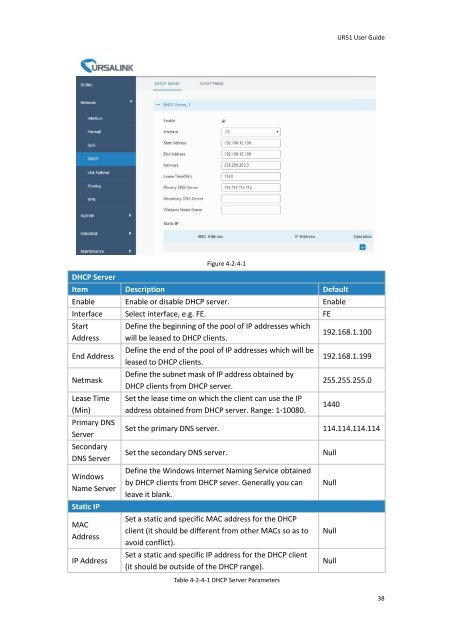Ursalink UR51 Industrial Cellular Router User Guide
You also want an ePaper? Increase the reach of your titles
YUMPU automatically turns print PDFs into web optimized ePapers that Google loves.
<strong>UR51</strong> <strong>User</strong> <strong>Guide</strong><br />
DHCP Server<br />
Figure 4-2-4-1<br />
Item Description Default<br />
Enable Enable or disable DHCP server. Enable<br />
Interface Select interface, e.g. FE. FE<br />
Start<br />
Address<br />
End Address<br />
Netmask<br />
Lease Time<br />
(Min)<br />
Primary DNS<br />
Server<br />
Secondary<br />
DNS Server<br />
Windows<br />
Name Server<br />
Static IP<br />
MAC<br />
Address<br />
IP Address<br />
Define the beginning of the pool of IP addresses which<br />
will be leased to DHCP clients.<br />
Define the end of the pool of IP addresses which will be<br />
leased to DHCP clients.<br />
Define the subnet mask of IP address obtained by<br />
DHCP clients from DHCP server.<br />
Set the lease time on which the client can use the IP<br />
address obtained from DHCP server. Range: 1-10080.<br />
192.168.1.100<br />
192.168.1.199<br />
255.255.255.0<br />
1440<br />
Set the primary DNS server. 114.114.114.114<br />
Set the secondary DNS server.<br />
Define the Windows Internet Naming Service obtained<br />
by DHCP clients from DHCP sever. Generally you can<br />
leave it blank.<br />
Set a static and specific MAC address for the DHCP<br />
client (it should be different from other MACs so as to<br />
avoid conflict).<br />
Set a static and specific IP address for the DHCP client<br />
(it should be outside of the DHCP range).<br />
Table 4-2-4-1 DHCP Server Parameters<br />
Null<br />
Null<br />
Null<br />
Null<br />
38




